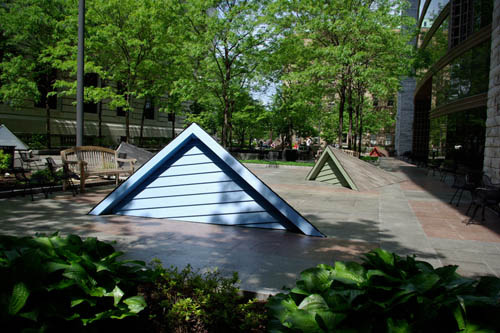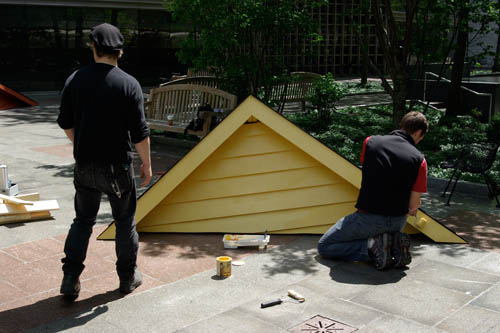 [Image: Watership Down by Maier Yagod and Jon Reed at the Cleveland Public Library].
[Image: Watership Down by Maier Yagod and Jon Reed at the Cleveland Public Library].
In a project for the Cleveland Public Library, designed by Toronto-based architects Maier Yagod and Jon Reed, “domestic fragments” have been embedded in the pavement, forming a surreal new kind of public bench:
Watership Down creates a scenario where five houses are frozen for a moment in a process of complete submersion into the ground of the Eastman Garden. Placed throughout the Garden, the gables of these houses project out of the earth at various angles. These create focal points of interest within the garden and become follies to climb, sit and rest upon.
Taken too far in one direction, of course, this idea could very easily become a kind of postmodern joke—architectural theme-props for a children’s playground—but the installation manages to avoid explicit dramaturgy, its fragments more like Gordon Matta-Clark’s Building Cuts emerging from the surface of the city.
 [Image: Watership Down by Maier Yagod and Jon Reed at the Cleveland Public Library].
[Image: Watership Down by Maier Yagod and Jon Reed at the Cleveland Public Library].
A fever of roofs pushing up from below, breaching ground level with the archaeological buoyancy of lost ships.
 [Image: Watership Down by Maier Yagod and Jon Reed at the Cleveland Public Library].
[Image: Watership Down by Maier Yagod and Jon Reed at the Cleveland Public Library].
While the deliberate use of simulated building fragments can run the risk, mentioned earlier, of simply repeating the PoMo theatrics of things like “upside-down buildings,” the evocation of underground architecture, like tombs, scratching through the earth, buried by an orderly landslide of the urban fabric around them, is an interesting direction to take.

http://www.scoutingny.com/?p=1026
Kinda curious – if those are park benches, I want to know where you sit? Could be painful.
http://lloydmintern.wordpress.com/2008/06/27/57-jumble/
The Strong International Museum of Play
I don't think I'm being a purist to observe that the photos clearly show the pieces sitting ON the ground, not emerging FROM it. This is a crucial detail that makes the difference between mysterious objects and playground equipment.
I agree, they don't look like they're coming out of the ground at all… give me po-mo theatrics any day.
(When I was a kid we used to drive regularly past a disco that really did seem to be jutting out of the ground, like the ones in the second row of the po-mo link, except it had simply the appearance of a box, without windows. It might have been a gimmick but it's still one of my favourite buildings.)
There is a similar idea at work outside the State Library of Victoria in Melbourne:
http://www.flickr.com/photos/13123990@N00/397055291/
the photos clearly show the pieces sitting ON the ground, not emerging FROM it
Indeed—as realized, this is the case (and this is also the weakness of the project, what you call "the difference between mysterious objects and playground equipment"). On the other hand, Lebbeus, your comment—and the discrepancy you point out—brings to mind what might be called the prepositional nature of architecture: how an object or space can be on, under, near, above, next to, against, between, within, etc., other spaces and objects, filling out the spatial grammar of a given site.
Buoyant is indeed the name of the game here. These are fun, whimsical – great!
Lebbeus, maybe we can rent Maier and Jon a backhoe for their next project.
Also similar to this project in Auckland New Zealand by John Radford.
http://www.flickr.com/photos/volker_nz/4885609/
Geoff: Nice observation–the prepositional.
"Pre-position"—the term itself is an explicit act of design!
Petrus Spronk's Architectural Fragment (1992) in Melbourne is similar in concept:
http://farm1.static.flickr.com/90/219877401_4e65705462.jpg .
I like your comment about Watership Down running the risk of becoming props for a children's playground. In Melbourne, Spronk's work has been hijacked by teenage skateboarders…
http://melbournecurious.blogspot.com